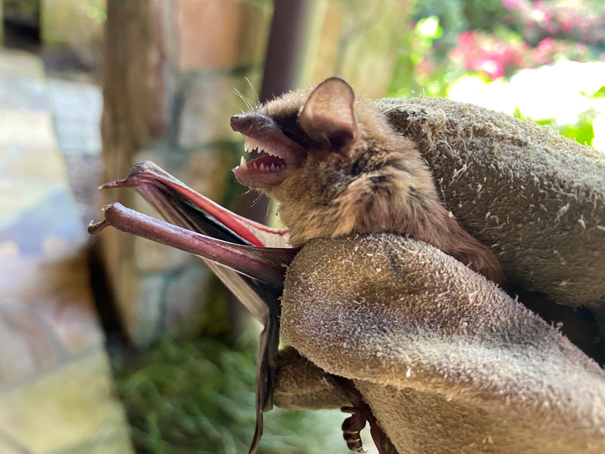
Bat Removal

Bats are amazing animals. Without them, our ecosystem would be out of balance. All bats in CITY are insectivores, and somebats can eat over 1,000 insects in one hour. Even considering the benefits, you do not want bats roosting in your house. Bats can damage your house and spread diseases. It can be dangerous to you and the bats to attempt DIY bat removal, and there are legal considerations too.
Common Areas Affected by Bats

Bats like warmth while they roost, and small cracks and holes around your home allow heat to escape. Bats feel even the slightest bit of heat and follow it inside, where they will locate a beam or other part of the structure for roosting.It can be challenging to find bat entry points due to their small size. Some may be in locations you cannot access physically or see just by looking. Therefore, hiring an expert is recommended.
- Attics
- Chimneys
- Roof Vents
- Roof Eaves
- Under Siding
At Critter Control Canada, we understand the intricacies of bat behaviour and habitat preferences. Our expertise allows us to address bat-related challenges and effectively develop tailored solutions for removal.
Bat Behaviour
Bats make sounds that are two or three times higher than humans can hear. When the flying mammals use echolocation, humans are only sometimes able to make out very quiet clicks.or three times higher than humans can hear. When flying.
Bats are nocturnal creatures and it can be difficult to hear them. But if a maternity colony gets large enough, you will be able to hear them in your attic. Residents may hear scratching and flapping sounds made by bats trapped inside attics or other areas of the home. Bat droppings, known as guano, are small and dark in coloration. The elongated pellets are crumbly and turn to dust when touched. Often used as fertilizer because of its high nitrogen and phosphorus content, guano can be dangerous when allowed to accumulate in the home.
Bat guano and urine are extremely corrosive. Over a long period of time, the accumulation in attics can cause wood, metals, and masonry to deteriorate.

Seasonal Issues Associated with Bats
Bats are most active during the warmer months spanning from spring through fall. While issues with bats are less common during other times of the year, Critter Control Canada remains available year-round to address any removal needs you may encounter.
Winter
Depending on the species, bats will either migrate or hibernate during the winter. If you have hibernating bats in your attic, do not disturb them!
Summer
Some bat species have established maternity roosts to give birth. It takes on average three to four weeks for a juvenile bat to learn to fly. Installing bat removal before a juvenile can fly will starve the babies..
Spring
Bats are returning from migration or coming out of hibernation. They are feeding on insects and finding a place to give birth. Maternity roosts can be in your house.
Fall
Bats are feeding to prepare for winter. Bats that hibernate will be looking for safe places to roost.
Preventative Measures
Preventative measures can act as a strong deterrent, but in some cases, this won’t stop bats from taking up residence near your home or business. For ongoing problems on your Vancouver property, we recommend professional bat removal services.

How to Prevent Bats from Invading
- Seal Entry points. Bats only use existing entry points to make their way into your home. Once your home is sealed, bats cannot create a new way inside
- Keep lights off outside. The lights will attract insects, and insects are a huge food source for bats.
- Minimizing water sources around your property, if possible, is a way to prevent bats and other wildlife from being a nuisance.
- Install a bat house.
Humane Bat Control Methods
The most effective and humane way to remove bats is by utilizing a bat valve in conjunction with a full home bat exclusion. A bat valve allows for bats to exit your home but not re-enter. Since each bat removal is unique, our specialist will use or create a bat valve specifically for your home. Our inspector will determine the proper amount of bat valves to be used, but most removals only require one bat valve. Once the bat valve is installed, all other bat entry points will be sealed, allowing for bats to only exit through the valve. The removal process typically takes 3-7 days. Our specialist will perform a final attic inspection before removing the valve. After removing the valve, the final entry point will be sealed, leaving your home bat-free.

Repair Services
The accumulation of bat guano is one of the most damaging parts of a bat infestation. Bat guano can spread diseases that infect people and damage your attic. After bat removal, we remove the guano, apply santization and ectoparasite agents, and in extreme cases replace attic insulation
Exclusion Measures
Bats gain access to attics through gaps in roof shingles, mortar, windows, doors, and home ventilation systems. Gable vents are a common bat entry point into the attic.
Our expert team can assess your property’s unique vulnerabilities and recommend tailored exclusion strategies to safeguard against raccoon invasions.

Professional Assistance Bat Removal in Vancouver
At Critter Control Canada, we specialize in humane bat removal. With our in-depth knowledge of bat behaviour and extensive expertise in wildlife removal, we are fully equipped to handle any bat infestations. Whether you’re dealing with bats in your attic, inside your walls, or inside a shed or barn, we can safely solve the bat problem.
Don’t let bats take over your property. Contact us today to schedule a consultation and take the first step towards a bat-free environment.